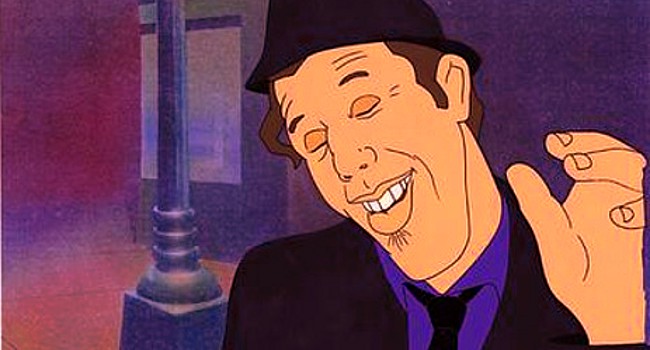Pioneering animated filmmaker Ralph Bakshi had already produced landmark films like Fritz the Cat, Heavy Traffic and The Lord of the Rings when he approached John Lamb at Lyon Lamb Animation Systems about building a rotoscope set-up that worked with video instead of film. Rotoscoping involves drawing and painting over images projected from live footage — the finished product looks like a cartoon, but the gestures and expressions of the characters are more true to life than a purely animated film could ever be.
Bakshi’s interest in a video system was no doubt financial as shooting on video would have sufficiently lowered his overhead while not having much impact on the finished images. Evidently, the filmmaker got impatient and bought $250 thousand worth of 35mm equipment for his next project before finding out that Lamb’s experiments had worked.
Anxious to try out his new gear, Lamb invited Tom Waits to be a part of an experimental short film that features the singer in a street corner seduction scene with a flirtatious stripper — the whole performance is centered on Waits’ recitation of “The One that Got Away.”
Tom Waits For No One has its own, brand new website. Here is the filmmaker on the 35th anniversary of his almost-lost milestone…
It was nearly two years before MTV’s debut, and seven years before an animated rock video would appear on MTV, but we were inspired by a burgeoning market: rock n’ roll videos. All we needed was a subject… and then I recalled Waits at The Roxy. With his evocative body language and signature vocals, Tom Waits’ motion would translate beautifully into animation. Creative juices began flowing, a pitch was hatched, phone calls were returned, storyboards drawn, and after several meetings with Tom, sets were built and production began.
We scheduled a video shoot. Tom drove up in his ’66 Blue Valentine T-bird, stepped out wearing a pork pie Stetson, an old wrinkled suit and carrying a bag, asking where the dressing rooms were. We’re thinking “Whew, he’s going to change that suit!” Then he came out of the dressing room with the same hat and a different old wrinkled suit.
For the shoot, we utilized 5 video cameras, 2 high, 2 low and 1 handheld. We did 6 takes with 2 separate dancers. We edited down 13 hours of video into to a 5 1/2 minute film, which was then traced frame by frame and turned into “Tom Waits for No One”. Too early for MTV, the film premiered in 1979, lived one night with “Mike ‘n Spike’s Festival of Animation” and took first prize at a single Los Angeles film and video festival. Ralph Bakshi’s American Pop was released in February 1981. On August 1, 1981, MTV went live and changed the world of music and video forever. Our little production, predating both, disappeared into obscurity.
After 35 years, in a world where music, video, animation and digital technology and young talent create new product on a global scale by the hour, “Tom Waits for No One” reaches out from the 20th century with the seeming draw of a throwback to analog itself. The live action images were hand traced frame by frame, turned into a caricatured drawing, inked onto a cel, then hand painted, photographed and edited on the most technology-forward analog video tools, by young artists who would transition into the 21st century’s digital world to become leaders in their industries.
This video might not be safe for work if seeing a flash of cartoon boobs on your lunch break could get you in trouble with your boss. Also, you should find a new job.
Stay Awake!
Please subscribe to my YouTube channel where I archive all of the videos I curate at Insomnia. Click here to check out more Cinema posts.










